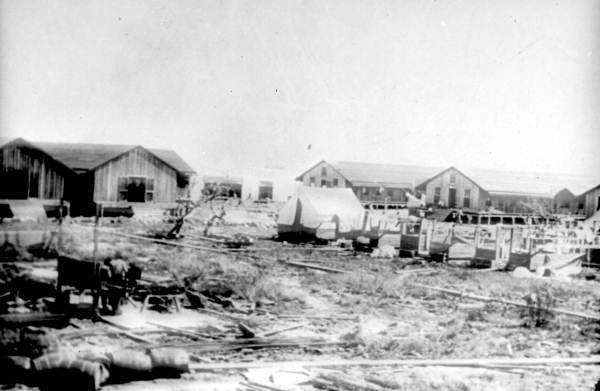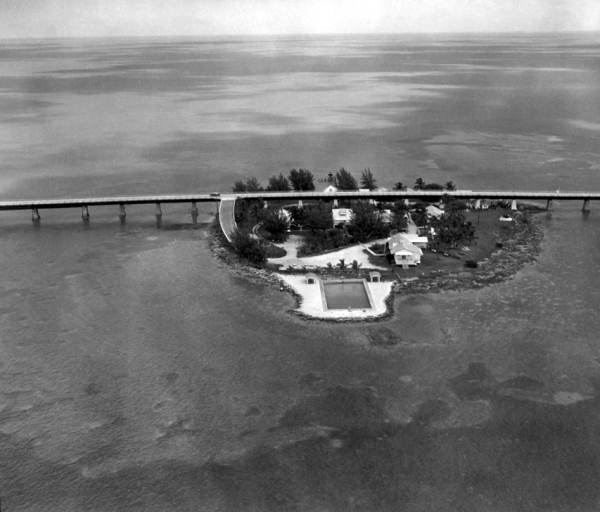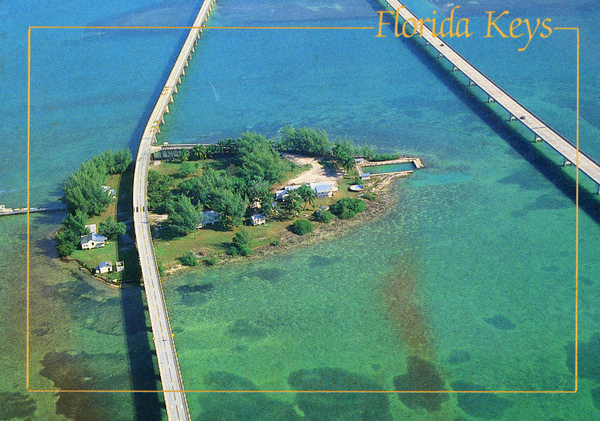Description of previous item
Description of next item
Funny Business on Pigeon Key
Published January 1, 2015 by Florida Memory
As you drive along the Seven Mile Bridge on U.S. 1 heading south toward Key West, you'll notice a small island off to the right around Mile Marker 45. The old Overseas Highway, parts of which are still in use for one purpose or another, runs right down to it. Like much of the scenery in that part of Florida, the place looks like it belongs on a postcard. And, well, it is on a number of postcards. None of them, however, mention the shadier episodes in the island's
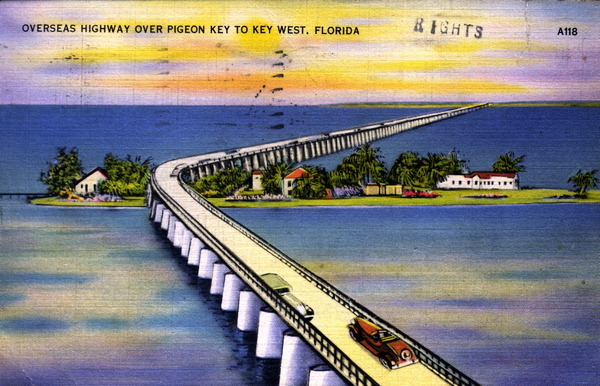
Postcard depicting Pigeon Key, with the original Overseas Highway running across it. The postmark on the reverse side of the card was from 1940.
Pigeon Key was a critical center of activity during the construction of Henry Flagler's Oversea Railroad linking Key West with the Florida mainland. The island served as a camp for hundreds of workers, and was converted to a maintenance base once the railway was completed in 1912.
The railway was a boon to the Florida Keys, of course, but not long after the road was completed, automobile enthusiasts began clamoring for the freedom to make their own way to Key West in their new machines. In 1933, the State Legislature created the Overseas Road and Toll Bridge District and authorized it to construct a toll road connecting Lower Matecumbe Key and Big Pine Key. This would complete the automobile route from Key West to the Florida mainland. The new commission studied several possibilities for building the route, but the option they selected came about completely by accident.
On September 2, 1935, the infamous Category 5 Labor Day Hurricane struck the Florida Keys, causing widespread destruction. Portions of the Florida East Coast Railway were destroyed, and the railway company ended up choosing to abandon its tracks across the Florida Keys rather than rebuild. The Overseas Road and Toll Bridge District saw an opportunity. Using a $3.6 million loan from the Public Works Administration, the commission purchased the tracks between Big Pine and Lower Matecumbe keys and refitted them with concrete decking and side rails. The newly completed highway opened on July 4, 1938.
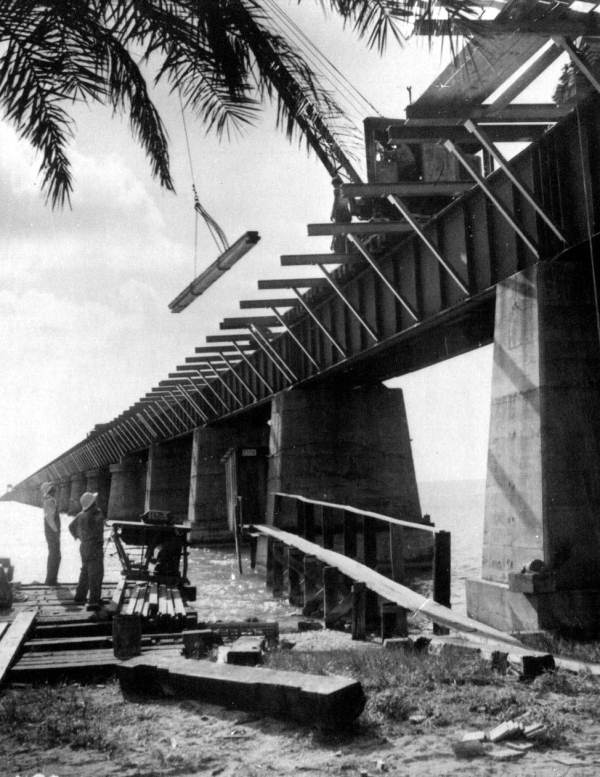
Converting the Florida East Coast Railway to the Overseas Highway between Big Pine Key and Lower Matecumbe Key. Note that a few crossties are still visible in this 1937 image.
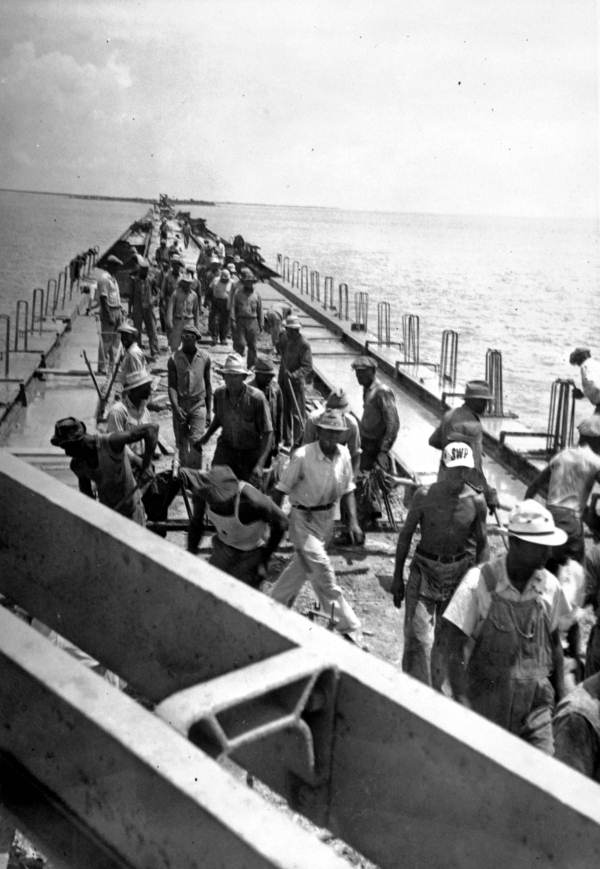
Converting the tracks of the Florida East Coast Railway into a new bridge for automobiles in the Florida Keys, ca. 1937
Once the road was built, the idea was that the Overseas Road and Toll Bridge District would repay the federal loan using tolls collected for travelers using the new bridges. That's where Pigeon Key comes in. The District established a headquarters building and maintenance base on the small island, with a small access road connecting it with the highway. Much of the business relating to maintenance, toll collection, and other matters was handled here.
As you might imagine, a gig working for the toll district in this island paradise was a nice assignment. Over time, however, some began to suspect it was a little too nice. In March 1954, the Miami Daily News began publishing a series of stories outlining activities at Pigeon Key that were raising a few eyebrows. The general manager of the toll authority, for example, was in the process of building a new real estate development north of Marathon, including a two-story home with a yacht basin for himself. This seemed awfully opulent for a man making $550 a month. The general manager refused the Miami Daily News reporters access to the District's files at Pigeon Key, so they conducted research in the public financial records archived at Tallahassee.
What they found suggested something was deeply wrong about how the District's funds were being spent. Expenses for the island headquarters included rabbit, squab, steaks selling at $1.77 a pound (in 1954, remember), bar supplies, and a variety of other expensive food items. The general manager also had at his disposal a cabin cruiser, a state-paid housekeeper and maid, and a $60,000 swimming pool. There was also evidence that state-owned property was being sold to persons connected with members of the District, and that District officials had tampered with the legal bidding process for contracts. Auditors later determined there were contracts let for work that was never completed, or for which the state was overcharged. Thousands of dollars' worth of building supplies were unaccounted for. On the recommendation of the State Road Board chairman, Cecil Webb, Acting Governor Charley Johns launched an investigation, and charges were brought against several of the persons connected with the corruption at Pigeon Key. Johns liquidated the Overseas Road and Toll Bridge District later in 1954, and all of its assets were transferred to the State Road Board.
The story has a happy ending, fortunately. In 1964, the University of Miami Marine Laboratory leased the island from the state and began using it as a base for scientific investigations. Today, the island is operated as a historical site and marine science learning center by the Pigeon Key Foundation, a non-profit organization. The Overseas Highway has long since been rebuilt, and now passes south of the island rather than directly over it. The old span, however, still connects the island to the new Seven Mile Bridge and U.S. 1. The old bridge is only open to foot traffic, however. Most visitors reach the island by ferry.
Cite This Article
Chicago Manual of Style
(17th Edition)Florida Memory. "Funny Business on Pigeon Key." Floridiana, 2015. https://www.floridamemory.com/items/show/273951.
MLA
(9th Edition)Florida Memory. "Funny Business on Pigeon Key." Floridiana, 2015, https://www.floridamemory.com/items/show/273951. Accessed December 5, 2025.
APA
(7th Edition)Florida Memory. (2015, January 1). Funny Business on Pigeon Key. Floridiana. Retrieved from https://www.floridamemory.com/items/show/273951

 Listen: The Assorted Selections Program
Listen: The Assorted Selections Program